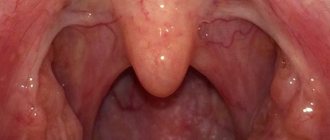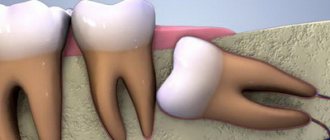The operation to remove the tonsils (tonsils) is called tonsillectomy. Surgery is performed for both children and adult patients. Tonsillectomy of the tonsils becomes necessary when the inflammatory process in the tonsils becomes permanent and becomes the cause of dangerous chronic intoxication of the body, as a result of which many of the patient’s organs suffer, for example, the heart, kidneys and joints.
The palatine tonsils belong to the human immune system. Their main role is to neutralize viruses and bacteria that enter the nasopharynx with air or food. The tonsils are collections of lymphoid tissue on both sides of the pharynx. When the tonsils come into contact with pathogenic microorganisms, active production of leukocytes occurs in them. They attack pathogenic flora and destroy it.
The surface of the tonsils is not smooth as it may seem. On its surface there are small depressions - lacunae. Their number reaches ten pieces. Inside, the tonsil is cut by a network of ornate canals - crypts, which approach the surface of the tonsils and end in lacunae.
Defeated bacteria, along with dead leukocytes, are independently removed from the tonsils and swallowed together with saliva. They dissolve in the stomach under the action of gastric juice. This is how the amygdala cleanses itself and prepares for a new defense.
The process described above is how it should be. This is how healthy tonsils behave. If a person’s immunity is weakened and the concentration of pathogenic microflora is too high, the tonsils’ own resources are not enough to defeat the enemy. Bacteria (most often the causative agent is streptococcus), not finding proper resistance, colonize the tonsils and begin to actively live in them, and inflammation of the tonsils occurs. This condition is called chronic tonsillitis.
Chronically inflamed tonsils are dangerous: instead of protecting the tonsils, they themselves become a source of inflammation, and waste products of bacteria are released into the blood and spread throughout the body, causing complications in other human systems: cardiovascular, excretory, musculoskeletal. Chronic tonsillitis can cause miscarriage and premature birth.
Most often, chronic inflammation of the tonsils develops against the background of untreated sore throat and is its complication. But there are other causes of chronic tonsillitis:
- chronic inflammation of the nasopharynx;
- allergy;
- constant stress;
- poor nutrition;
- non-compliance with the work and rest schedule;
- working or living in unfavorable conditions (dust, gas pollution, inhalation of harmful vapors or substances);
- bad habits;
- heredity.
Since there are many social and everyday factors among the causes of the disease, chronic tonsillitis is called a social disease. Moreover, the number of patients with this diagnosis is growing year by year.
With chronic tonsillitis, you don’t need to think about surgery right away. It is necessary to try conservative treatment methods, which include drug therapy, lavage of the palatine tonsils and physiotherapeutic procedures. The patient's "I want" alone is not enough to remove the tonsils. After all, it is an important protective organ. He needs to be given a chance and helped to restore his functions. And only if conservative therapy does not help, and irreversible pathological processes occur in the body, is unilateral or bilateral removal of the tonsils performed.
Sign up for a tonsil removal service right now!
Make an appointment
What is tonsillectomy?
Removal of palatine tonsils is one of the most common operations in the practice of an ENT doctor.
Many people think that it is performed only for children, but this is not so. Adults may also need it if chronic tonsillitis has become severe and is accompanied by purulent complications, and enlarged tonsils interfere with swallowing and even breathing, causing sleep apnea syndrome - a short-term cessation of breathing during sleep. The palatine tonsils sometimes become inflamed. Inflammation of the tonsils (tonsils) is referred to as tonsillitis. It, in turn, can be acute and chronic.
Inflammation of the tonsils. Photo: James Heilman, MD / (Creative Commons Attribution-Share Alike 3.0 Unported license)
Acute tonsillitis is called tonsillitis. With chronic tonsillitis, the inflammatory process lasts for years, with periodic exacerbations. An exacerbation is usually accompanied by fever, sore throat and sore throat, including when swallowing.
The tonsils become coated, bad breath appears, and the cervical lymph nodes become enlarged. If exacerbations recur one after another, and conservative treatment does not help, you have to resort to surgical treatment - removal of the tonsils (tonsillectomy).
Where is the best place to have surgery?
First of all, see a doctor you trust. In order to form an opinion or make a decision about the operation, the patient needs to talk with the doctor, ask questions that interest him, find out the features of the operation, rehabilitation, etc. Therefore, it is best to first visit the doctor who will operate on you and talk with him and ask all your questions.
The choice of the medical institution where you are going to receive medical care will depend on many factors, and everyone has their own priorities. I would just like to emphasize that your choice should still be made based on the trust in this institution that you or your loved ones have already formed, on performance indicators and the high professionalism of the team.
At Medical Plaza MC, tonsillectomy is performed at the highest level. Experienced ENT specialists conduct modern diagnostics and help you choose the most effective method of treating chronic tonsillitis.
Difference from tonsillotomy
Along with tonsillectomy, there is another operation with a similar name - tonsillotomy, in which enlarged tonsils are removed not entirely, but partially (usually in children). The indication for such an operation is the hypertrophy of these tonsils, when they occupy the entire space from the anterior palatine arch to the midline of the pharynx. With tonsillotomy, only the “excess” of enlarged tonsils is removed, returning them to normal size. Tonsillotomy is less traumatic than radical removal of the tonsils, and allows you to preserve their protective functions.
Complications and how to avoid them
One of the very rare complications: velopharyngeal insufficiency. After surgery, velum closure may be impaired. This complication is manifested by the appearance of a nasal voice in the patient, the appearance of snoring during sleep, and disturbances in the processes of speech and swallowing food. More often, this complication appears in patients with a hidden cleft of the hard palate that was not diagnosed before surgery. To exclude such a condition, a thorough examination of patients is necessary. One of the signs of the presence of a submucosal cleft of the hard palate is the splitting of the uvula.
Why doesn't conservative treatment help?
Due to immunodeficiency (congenital or acquired) or concomitant diseases that contribute to prolonged inflammatory processes (diabetes mellitus, chronic infection), conservative treatment of tonsillitis may be ineffective.
Important! Group A beta-hemolytic streptococcus can settle in the tonsils, which causes rheumatic damage to the heart, joints and kidneys. Removing the tonsils avoids these complications.
Other factors that complicate conservative treatment include smoking and alcohol abuse. For teachers, singers and actors, the risk factor is the need to talk long, loudly and a lot.
At what age is surgery performed?
Surgical treatment may be recommended for adults and children over 8 years of age. By this time, the tonsils are fully formed. The palatine tonsils are an integral part of the pharyngeal ring - a group of tonsils (paired palatine and tubal, unpaired nasopharyngeal and lingual) - an important organ of local immunity of the nasopharynx and respiratory tract. Early removal of tonsils can contribute to the development of atopic diseases - allergic rhinitis or bronchial asthma. Such operations are usually not performed on children under three years of age, since they rarely have tonsillitis - the tonsils are too small.
Important! Tonsils can be removed no earlier than six months after polio vaccination.
Palatine tonsils
Palatine tonsils are small structures that actually look like almond grains and are located between the arches of the palate. In common parlance they are sometimes called “tonsils.” They consist of lymphoid tissue enclosed in a connective tissue capsule. The tonsils have lacunae - slits that greatly increase the surface of the palatine tonsil. They are part of a lymphatic “ring” surrounding the pharynx. Their role is to capture “samples” of microbes entering the body with air, water and food, and report information about them to other immune organs, which produce antibodies - proteins that destroy microbes. The first “acquaintance” with the microbe occurs in the tonsils, which allows the body to fight it. This function of the tonsils is especially important in the first years of life. With age, it becomes less significant, since the same work is performed by lymphoid tissue located in the thickness of the mucous membrane throughout the respiratory tract.
The anatomical features of the tonsils and their constant contact with infection in the oral cavity create the conditions for the development of inflammation of the tonsils - tonsillitis. This inflammation can be acute or chronic.
Contraindications
They can be absolute (excluding the possibility of tonsillectomy) and relative, when everything is postponed until the reasons preventing the operation are eliminated.
Absolute contraindications:
- diseases with increased bleeding: hemophilia, hemorrhagic diathesis, Werlhof's disease, agranulocytosis, leukemia;
- heart failure grade 2–3;
- acute infectious diseases and exacerbation of chronic ones;
- active form of tuberculosis;
- cirrhosis of the liver.
Relative contraindications:
- caries (before sanitation - dental prophylaxis of the oral cavity);
- inflammation of the gums;
- pustular diseases of the mouth and skin;
- ARVI and influenza;
- exacerbation (decompensation) of chronic diseases;
- menstruation;
- pregnancy after the 26th week due to the risk of premature birth.
A correspondent of the Kazanskie Vedomosti newspaper talked about this with Boris Revzin, an otorhinolaryngologist of the highest category at the ENT center of the city clinical hospital No. 16.
— Boris Arkadyevich, in what cases does the question of removing the tonsils arise? — Very often we remove tonsils when conservative treatment of chronic tonsillitis is ineffective. Chronic tonsillitis is a long-term inflammation of the pharyngeal and palatine tonsils, often accompanied by inflammation of the mucous membrane of the pharynx. If a person has frequent tonsillitis (more than twice a year), we first carry out conservative treatment. First of all, the patient is examined for microflora and its sensitivity to various medications (for this, a swab is taken from the throat). Next, rinsing of the lacunae of the palatine tonsils is prescribed to cleanse them of caseous plugs, massage of the palatine tonsils. And if this treatment does not produce results - namely, long-term remission, then in such a situation it is possible to perform a tonsillectomy - an operation to remove the tonsils.
We also perform this operation if chronic tonsillitis causes complications in the form of concomitant diseases: rheumatoid arthritis, endocarditis, inflammatory autoimmune diseases of the thyroid gland, chronic inflammatory kidney diseases.
The absolute indication for removal of the tonsils is a complication of tonsillitis such as a peritonsillar abscess. This is an acute inflammation in the peritonsil tissue, a severe purulent lesion of the oropharynx. It occurs when a sore throat is treated incorrectly, when, for example, a person does not take antibiotics or takes them incorrectly. Or in the absence of treatment for the disease.
— And how does removing tonsils solve the problem of frequent sore throat? — In cases where there are indications for tonsillectomy. The tonsils are a source of chronic infection for the body. Microbes live in their lacunae and caseous plugs are formed: waste products of these microbes, desquamated epithelium and food debris. Sometimes the tonsils, by their very structure, are very loose, with widened lacunae. In this case, food debris will often get stuck in them, which can lead to chronic inflammation.
In addition, if antibodies begin to be produced to the causative agent of inflammation, streptococcus, then after some time they attack the body’s own cells and tissues. Thus, here we are already dealing with the autoimmune nature of the disease, affecting the tissues of the heart, kidneys, liver, and thyroid gland.
— Why does the issue of removing the tonsils cause a lot of controversy and there is no consensus among doctors about whether the patient needs to take this step? What do you think about this? — Regarding tonsillectomy, there is often a lot of conflicting information in the media and on the Internet. This may be due to the fact that earlier, in the 1970s and 1980s, tonsils were removed very often; this did not always give the desired result. Now we carefully examine the patient before referring him for a tonsillectomy. Before this step, it is necessary to determine whether there are any other causes of tonsil disease. Maybe the tonsils suffer from problems of the upper respiratory tract, such as a deviated nasal septum with delayed nasal breathing and so on. Or, as often happens in the case of pharyngotonsillitis, the development of a chronic disease is provoked by the Helicobacter bacterium, which causes diseases of the gastrointestinal tract.
— What are the contraindications for this operation? - Absolute contraindication - blood diseases. Because tonsillectomy may cause heavy bleeding. Relative contraindications are severe somatic pathology: myocardial infarction, angina pectoris, severe heart and renal failure, high degree of hypertension, severe diabetes mellitus, active form of tuberculosis. You should not remove tonsils during menstruation, in the last months of pregnancy, or during acute infection. The operation is carried out no earlier than two to three weeks after suffering from a sore throat, flu or other illness.
— Can removal of the tonsils lead to a decrease in immunity? After all, they are part of the human immune system... - No, you don’t need to be afraid of that. First, we do not remove all lymphoid tissue. Lymphoid tissue is present both at the root of the tongue and in the nasopharynx. The lingual tonsil is also part of the immune system. After the tonsils are removed, they take over the function of the palatine tonsils. Secondly, diseased tonsils are no longer of any use: they do not protect a person from infection, but themselves are its source and poison the body.
— Is it true that after such an operation a person’s voice can become quieter? - No, her voice does not become quieter, except perhaps only in the first time after the operation.
— Is tonsil removal performed under general anesthesia? — We perform tonsillectomy under both local and general anesthesia. When choosing it, we look at the overall picture, the severity of the pharyngeal gag reflex. Because of this, not every patient can, in principle, have this operation without anesthesia. Therefore, if a person has a pronounced gag reflex, it is, of course, more advisable to perform a tonsillectomy under general anesthesia. Many patients themselves want to have this operation performed under anesthesia.
— How is tonsillectomy performed? — The operation lasts from 30 minutes to an hour, depending on the severity of the bleeding. This is a surgical operation during which a radio wave scalpel is used. This modern radio wave equipment can reduce bleeding. It is also used after direct cutting of the tonsils, when it is necessary to cauterize the bleeding vessels at the site of the removed organ. The radio wave coagulator does this superficially without causing severe burns.
By the way, I want to note that tonsillectomy is not the only type of surgery on the tonsils. There is also a tonsillotomy (partial removal of the tonsils), which is usually done for children if the tonsils are enlarged. And lacunotomy - when, after washing the tonsils, incisions are made on them with a radio wave scalpel in order to thus seal the recesses in the tonsils, preventing the accumulation of microbes in this organ and the formation of plugs in it.
— Is lacunotomy an alternative to tonsil removal? - No. Rather, it is an intermediate stage between conservative treatment and tonsillectomy. But, unfortunately, this method is not as effective as removing tonsils. It can be used for tonsil cysts.
— Does removal of tonsils require hospitalization? And if so, how long does the person spend in the hospital? — In the absence of any postoperative complications, patients remain in the clinic for two to three days. But even after discharge, we keep in touch with them just in case. On the first day after surgery, the patient should not talk or eat.
In the following days, in this case, a gentle diet using mainly liquid food is required. For two weeks after tonsillectomy, the patient should limit physical activity, not lift weights, not visit the bathhouse or sauna, and follow a diet.
— Do you have many patients whose tonsils are removed? “We carry out about three or four such operations a week. Many people do not want to part with their tonsils and go on rinsing ad infinitum. I would like to add that if there are indications for tonsillectomy, it is better to do it at a young age, when the body tolerates the operation more easily and complications in the form of associated diseases have not yet appeared.
Types of tonsil removal surgeries
Classical
The surgeon installs a mouth retractor and separates the tonsil tissue along with the capsule from the surrounding tissues in a “blunt” way using a raspator. The bleeding is stopped, the vessels are cauterized with an electrocoagulator or laser. The whole process takes from 15 to 40 minutes.
Electrocoagulation
Figure 1. Incision at the base of the tonsil during electrocoagulation.
Source: Maxillofacial Plastic and Reconstructive Surgery / Open-i (Attribution 4.0 International) Instead of a scalpel, a high-frequency current electrode is used. The vessels are “sealed”, so blood loss is minimal. Recovery may take longer due to associated injuries to surrounding tissues.
Removed tonsils. Maxillofacial Plastic and Reconstructive Surgery / Open-i (Attribution 4.0 International)
Cryodestruction
Tonsils are frozen with liquid nitrogen. As a result, they become pale, flat and hard, and after a day they die and are gradually rejected. The method is recommended for patients with an increased risk of bleeding (thrombocytopenic purpura, hemophilia, etc.), severe heart failure and endocrine pathology.
Important! The cryosurgical method is used in a series of procedures lasting up to 1.5 months. During this time, a relapse of the disease is possible if not all of the tonsil tissue has been destroyed. Cryosurgery is used when classical surgery is not possible.
Ultrasonic destruction
High-frequency sound vibrations warm up the tissues to prevent bleeding. Unlike exposure to liquid nitrogen or electricity, surrounding tissue is almost not damaged. Ultrasound method is one of the least traumatic.
Radio wave destruction
A probe is installed inside the tonsils, which generates radio waves. They evaporate the water from here and cause scarring. Ablation can be repeated several times. Anesthesia is not needed here - only local anesthesia or light sedation. Recovery is quick, but radical tonsil removal is almost impossible. Therefore, radio wave therapy is used for their hypertrophy, but not for chronic tonsillitis, when radical intervention is required.
Cold plasma destruction
A relatively new method of removing tonsils. It is based on the property of cold plasma (radio frequency energy converted into ionic dissociation) to separate molecular bonds in tissues without releasing thermal energy. Plasma is called cold because it causes minimal heating of the tissue, which means that pain after surgery will be insignificant, recovery will be easy and quick. The method is low-traumatic and can be used for partial or complete removal of tonsils.
Laser removal
Laser tonsillectomy can be complete or partial (with cutting of the upper layers of the tonsils). Different types of laser are used - carbon, infrared, etc. Only pathological tissues are removed, and healthy ones are not affected. Other advantages include immediate separation of the tonsil from the underlying tissues with coagulation of blood vessels, which reduces the risk of bleeding and infection.
What type of pain relief is best to choose?
Tonsillectomy was previously considered an operation that did not require more severe pain relief than local anesthetics (infiltrative). It should be noted that a feature of operations performed on the ENT organs, even minor ones, is pronounced subjective discomfort in the patient - emotionally, any interventions in the head and neck area are much more difficult to tolerate than interventions in the torso and limbs. It is the fear of surgery that stops many patients. The solution to this problem is general anesthesia, which became possible thanks to the active development of anesthesiology and has recently been widely used during this intervention. Also, the possibility of general anesthesia solves the issue of performing surgery in patients who have a history of allergic reactions to local anesthetics.
Postoperative period
Figure 2. Appearance of the throat after tonsillectomy. Source: James Heilman MD, CC BY-SA 3.0.
Recovery usually takes 3–4 weeks, the first of which takes place in the hospital. This is necessary in order to respond in time to the most common complication of tonsillectomy – pharyngeal bleeding. To prevent it, hemostatic drugs are prescribed.
From the operating room the patient is transferred to a ward under the supervision of the attending physician. On the first day, it is forbidden to swallow, spit or expectorate saliva. You can only breathe through your mouth. In case of severe pain, the patient is prescribed painkillers.
A diet is recommended for all days of the postoperative period
- on the first day, adults should refrain from eating, and small children should not eat or drink for the next 6 hours;
- In the first week after surgery, it is recommended to eat liquid, smooth food;
- During the recovery period, food should be soft; it is not recommended to eat too hot, cold, sour, or spicy. This may irritate the mucous membranes of the throat and mouth.
- In the postoperative period, if necessary, a course of antibiotics is prescribed.
Figure 3. Memo: what you can and cannot eat after surgery.
Source: verywellhealth.com Bed rest must be observed for 2 days. In most cases, the patient is discharged from the hospital within a week for outpatient observation and treatment.
Complications after removal of tonsils
The most common of them is bleeding, which can develop both on the first day after the intervention (primary bleeding, and 5-6 days after it. The incidence of postoperative pharyngeal bleeding ranges, according to various observations, from up to almost 60%. Minor bleeding after removal of the tonsils is stopped using a tampon, electrocoagulation, or the anterior and posterior palatine arches are sutured together to reduce the area of bleeding.
Also, as a side effect of the procedure, there is a risk of blood aspiration (blood entering the respiratory tract). Then the blood is urgently removed with an electric suction and bronchoscopy is performed.
After removal of the tonsils, swelling of the soft palate and larynx is possible. If signs of difficulty breathing appear, decongestant therapy is carried out.
If the wound becomes inflamed after removal of the tonsils, antibiotic therapy is prescribed.
In most cases, the operation takes place without complications or side effects. If the patient experiences pain, the doctor will prescribe analgesics on the first day after removal of the tonsils, and then non-steroidal anti-inflammatory drugs.
Sometimes the patient may experience voice changes, taste disturbances, and nasal sounds.
It is extremely rare to experience damage to the temporomandibular joint due to forceful opening of the mouth with a mouth opener during tonsil removal.
Preparing for removal
Carrying out a tonsillectomy requires certain preparation. The patient must undergo a preoperative examination, which includes:
- conducting a number of laboratory tests (general blood test, urine test, coagulogram, test for HIV and infections, etc.);
- fluorography;
- ECG;
- taking a smear from the mucous membrane of the tonsils and the back wall of the pharynx;
- sanitation of the oral cavity;
- examination by a therapist and, if necessary, doctors of narrow specializations (rheumatologist, endocrinologist, gynecologist, etc.).
If the patient is taking medications that inhibit blood clotting (anticoagulants), they should be stopped a few days before the tonsillectomy. To relieve anxiety before having your tonsils removed, you can start taking sedatives.
On the appointed day, four to six hours before the intervention, it is necessary to finish eating so as not to provoke a gag reflex, and the anesthesia will work better.
Sources
1. Palchun V.T.
Otorhinolaryngology: national guidelines. M.: GEOTAR-Media, 2016. 2. Karpishchenko S.A., Svistushkin S.M. Chronic tonsillitis and tonsillitis. Immunological and clinical aspects. St. Petersburg: Dialogue, 2017.
3. Lukan N.V., Sambulov V.I., Filatova E.V. Conservative treatment of various forms of chronic tonsillitis. Almanac of Clinical Medicine, 2010, 23: 37-41.
4. Belov, B.S., Shcherbakova M.Yu. A-streptococcal tonsillitis: modern aspects. Pediatrics. 2009, 88(5): 127-135.
5. Turovsky A.B, Kolbanova I.G. Chronic tonsillitis - modern concepts. Doctor.RU, 2009, 49(5): 16-21.
Testing to confirm the need for tonsillectomy
This diagnosis of “decompensated form of chronic tonsillitis” is established on the basis of a set of data, including the history of the disease, clinical picture, laboratory data (biochemical blood test with determination of antistreptolysin-O, rheumatoid factor, C-reactive protein, study of the immunological function of the palatine tonsils), and also the presence of complications: rheumatism, infectious nonspecific polyarthritis, diseases of the heart, kidneys, thyroid gland, purulent complications (peritonsillar abscess), information about the ineffectiveness of previous conservative treatment.
Study of the functional state of the palatine tonsils











